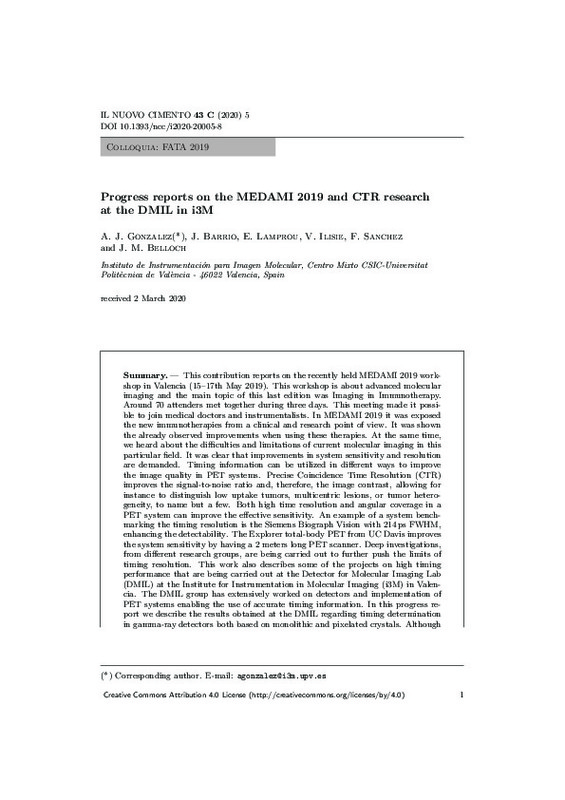|
Resumen:
|
[EN] This contribution reports on the recently held MEDAMI 2019 workshop in Valencia (15-17th May 2019). This workshop is about advanced molecular imaging and the main topic of this last edition was Imaging in Immunotherapy. ...[+]
[EN] This contribution reports on the recently held MEDAMI 2019 workshop in Valencia (15-17th May 2019). This workshop is about advanced molecular imaging and the main topic of this last edition was Imaging in Immunotherapy. Around 70 attenders met together during three days. This meeting made it possible to join medical doctors and instrumentalists. In MEDAMI 2019 it was exposed the new immunotherapies from a clinical and research point of view. It was shown the already observed improvements when using these therapies. At the same time, we heard about the difficulties and limitations of current molecular imaging in this particular field. It was clear that improvements in system sensitivity and resolution are demanded. Timing information can be utilized in different ways to improve the image quality in PET systems. Precise Coincidence Time Resolution (CTR) improves the signal-to-noise ratio and, therefore, the image contrast, allowing for instance to distinguish low uptake tumors, multicentric lesions, or tumor heterogeneity, to name but a few. Both high time resolution and angular coverage in a PET system can improve the effective sensitivity. An example of a system benchmarking the timing resolution is the Siemens Biograph Vision with 214 ps FWHM, enhancing the detectability. The Explorer total-body PET from UC Davis improves the system sensitivity by having a 2 meters long PET scanner. Deep investigations, from different research groups, are being carried out to further push the limits of timing resolution. This work also describes some of the projects on high timing performance that are being carried out at the Detector for Molecular Imaging Lab (DMIL) at the Institute for Instrumentation in Molecular Imaging (i3M) in Valencia. The DMIL group has extensively worked on detectors and implementation of PET systems enabling the use of accurate timing information. In this progress report we describe the results obtained at the DMIL regarding timing determination in gamma-ray detectors both based on monolithic and pixelated crystals. Although with 15 min thick LYSO blocks it was tough to obtain values of CTR below 500 ps when using analog SiPMs and ASIC-based readout, this was improved down to 250 ps if small 3 mm size and 6 mm height pixels under the one-to-one coupling approach were enabled. This type of approach, the one-to-one coupling, seems to benefit from the light collection in a single photosensor element and, therefore, to improve the timing properties. Monolithic blocks offer, on the contrary, advantages such as photon depth of interaction. In order to separate Compton and photoelectric events we have thought of a detector block design with a high aspect ratio, using LYSO crystals of 51 mm size vs. 3 mm thickness, read-out by the four lateral sides. We have demonstrated the possibility to reach below 2 mm FWHM spatial resolution with an energy resolution of 12%.
[-]
|
|
Agradecimientos:
|
The DMIL work presented in this paper has received funding from the European Research Council (ERC) under the European Union's Horizon 2020 research and innovation program (grant agreement No. 695536). It has also been ...[+]
The DMIL work presented in this paper has received funding from the European Research Council (ERC) under the European Union's Horizon 2020 research and innovation program (grant agreement No. 695536). It has also been supported by the Spanish Ministerio de Economia, Industria y Competitividad under Grant TEC2016-79884-C2-1-R. The author would like to thank all current and former members of the DMIL at i3M for their continuous contributions to this work.
[-]
|









